Barrel


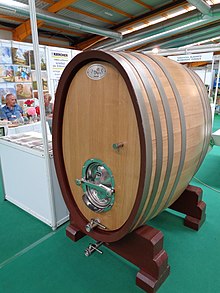
Abarrelorcaskis a hollowcylindricalcontainer with a bulging center, longer than it is wide.[1][2]They are traditionally made of woodenstavesand bound by wooden ormetalhoops. The wordvatis often used for large containers for liquids, usually alcoholic beverages;[3]a small barrel or cask is known as akeg.[4]
Barrels have a variety of uses, including storage of liquids such as water, oil, and alcohol. They are also employed to hold maturing beverages such aswine,cognac,armagnac,sherry,port,whiskey,beer,arrack,andsake.Other commodities once stored in wooden casks includegunpowder,meat,fish, paint, honey, nails, andtallow.
Modern wooden barrels for wine-making are made of French common oak (Quercus robur), whiteoak(Quercus petraea), American white oak (Quercus alba), more exotic is mizunara oak (Quercus crispula),[5]and recently Oregon oak (Quercus garryana) has been used.[6] Someone who makes traditional wooden barrels is called acooper.Today, barrels and casks can also be made ofaluminum,stainless steel,and differenttypes of plastic,such asHDPE.
Early casks were bound with wooden hoops and in the 19th century these were gradually replaced by metal hoops that were stronger, more durable and took up less space.
Barrelhas also been used as astandard size of measure,referring to a set capacity or weight of a given commodity. For example, in the UK and Ireland, a barrel of beer refers to a quantity of 36 imperial gallons (160 L; 43 US gal), and is distinguished from other unit measurements, such asfirkins,hogsheads,andkilderkins.[7]Wine was shipped in barrels of 119 litres (31 US gal; 26 imp gal). A barrel of oil, defined as 42 US gallons (35 imp gal; 160 L), is still used as a measure of volume for oil, although oil is no longer shipped in barrels. The barrel has also come into use as ageneric termfor a wooden cask of any size.
History[edit]
AnEgyptian wall-paintingin the tomb ofHesy-Ra,dating to 2600 BC, shows a wooden tub used to measure wheat and constructed of staves bound together with wooden hoops.[8]Another Egyptian tomb painting dating to 1900 BC shows a cooper and tubs made of staves in use at the grape harvest.[9]Herodotus(c. 484 –c. 425 BC) allegedly reports the use of "palm-wood casks" in ancientBabylon,but some modern scholarship disputes this interpretation.[10]
In Europe, buckets and casks dating to 200 BC have been found preserved in the mud oflake villages.[11]A lake village nearGlastonburydating to the lateIron Agehas yielded one complete tub and a number of wooden staves.
TheRomanhistorianPliny the Elder(died 79 AD) reported that cooperage in Europe originated with theGaulsin Alpine villages who stored their beverages in wooden casks bound with hoops.[12]Pliny identified three different types of coopers: ordinary coopers, wine coopers and coopers who made large casks.[13]Large casks contain more and bigger staves and are correspondingly more difficult to assemble. Roman coopers tended to be independent tradesmen, passing their skills on to their sons. The Greek geographerStrabo(c.64 BC toc.24 AD) recorded that woodenpithoi(barrels or wine-jars) were lined with pitch to stop leakage and preserve the wine.[14]
Barrels were sometimes used for military purposes.Julius Caesar(100 to 44 BC) usedcatapultsto hurl burning barrels of tar into besieged towns to start fires.[15]The Romans also used empty barrels to makepontoon bridgesto cross rivers.

Empty casks were used to line the walls of shallow wells from at least Roman times. Such casks were found in 1897 during archaeological excavations of RomanSilchesterin Britain. They were made ofPyrenean silver firand the staves were 38 mm (1.5 in) thick and featured grooves where the heads fitted. They had Roman numerals scratched on the surface of each stave to help with re-assembly.[15]
InAnglo-SaxonBritain, wooden barrels were used to store ale, butter, honey andmead.Drinking-containers were also made from small staves ofoak,yeworpine.These items required considerable craftsmanship to hold liquids and might be bound with finely-worked precious metals. They were highly valued items and were sometimes buried with the dead asgrave goods.[16]
Uses today[edit]
Beverage maturing[edit]



An "ageing barrel" is used toage wine;distilled spiritssuch aswhiskey,brandy,orrum;beer;tabasco sauce;or (in smaller sizes)traditional balsamic vinegar.When a wine or spirit ages in a barrel, small amounts ofoxygenare introduced as the barrel lets some air in (compare tomicrooxygenationwhere oxygen is deliberately added). Oxygen enters a barrel whenwateroralcoholis lost due toevaporation,a portion known as the "angels' share". In an environment with 100% relativehumidity,very little water evaporates and so most of the loss is alcohol, a useful trick if one has a wine with very high proof. Most beverages are topped up from other barrels to prevent significant oxidation, although others such asvin jauneandsherryare not.
Beverages aged in wooden barrels take on some of the compounds in the barrel, such asvanillinand woodtannins.The presence of these compounds depends on many factors, including the place of origin, how the staves were cut and dried, and the degree of "toast" applied during manufacture. Barrels used for aging are typically made of French or Americanoak,butchestnutandredwoodare also used. Some Asian beverages (e.g., Japanesesake) useJapanese cedar,which imparts an unusual, minty-piney flavor. In Peru and Chile, a grape distillate namedpiscois either aged in oak or inearthenware.
Wines[edit]
Some wines are fermented "on barrel", as opposed to in a neutral container like steel or wine-gradeHDPE(high-density polyethylene) tanks. Wine can also be fermented in large wooden tanks, which—when open to the atmosphere—are called "open-tops". Other wooden cooperage for storing wine or spirits range from smaller barriques to huge casks, with eitherellipticalor round heads.
The tastes yielded by French and American species of oak are slightly different, with French oak being subtler, while American oak gives stronger aromas.[17]To retain the desired measure of oak influence, awinerywill replace a certain percentage of its barrels every year, although this can vary from 5 to 100%. Some winemakers use "200% new oak", where the wine is put into new oak barrels twice during the aging process.Bulk winesare sometimes more cheaply flavored by soaking inoak chipsor added commercial oak flavoring instead of being aged in a barrel because of the much lower cost.
Sherry[edit]
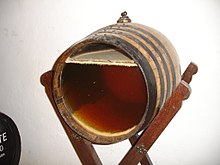
Sherryis stored in 600-litre (130 imp gal; 160 US gal) casks made of North American oak, which is slightly more porous than French or Spanish oak. The casks, or butts, are filled five-sixths full, leaving "the space of two fists" empty at the top to allowflorto develop on top of the wine. Sherry is also commonly swapped between barrels of different ages, a process that is known assolera.
Spirits[edit]
Whiskey[edit]

Laws in several jurisdictions require that whiskey be aged in wooden barrels. The law in the United States requires that "straight whiskey"(with the exception ofcorn whiskey) must be stored for at least two years in new, charred oak containers.[18]Other forms of whiskey aged in used barrels cannot be called "straight".[18]
International laws require any whisky bearing the label "Scotch"to be distilled and matured inScotlandfor a minimum of three years and one day in oak casks.[19]
By Canadian law,[20]Canadian whiskiesmust "be aged in small wood for not less than three years", and "small wood" is defined as a wood barrel not exceeding 700 litres (150 imp gal; 180 US gal) capacity.
Since the U.S. law requires the use of new barrels for several popular types of whiskey, which is not typically considered necessary elsewhere, whiskey made elsewhere is usually aged in used barrels that previously contained American whiskey (usuallybourbon whiskey). The typical bourbon barrel is 53 US gallons (200 L; 44 imp gal) in size, which is thus thede factostandard whiskey barrel size worldwide.[21][22]Some distillers transfer their whiskey into different barrels to "finish" or add qualities to the final product. These finishing barrels frequently aged a different spirit (such as rum) or wine. Other distillers, particularly those producing Scotch, often disassemble five used bourbon barrels and reassemble them into four casks with different barrel ends for aging Scotch, creating a type of cask referred to as ahogshead.[23]
Brandy[edit]
Maturing is very important for a goodbrandy,which is typically aged in oak casks. The wood used for those barrels is selected because of its ability to transfer certain aromas to the spirit.Cognacis aged only in oak casks made from wood from theForest of Tronçaisand more often from the Limousin forests.
Tequila[edit]
Some types oftequilaare aged in oak barrels to mellow its flavor. "Reposado" tequila is aged for a period of two months to one year, "Añejo" tequila is aged for up to three years, and "Extra Añejo" tequila is aged for at least three years. Like with other spirits, longer aging results in a more pronounced flavor.
Beer[edit]
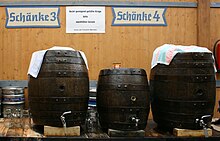
Beersare sometimes aged in barrels which were previously used for maturing wines or spirits. This is most common in darker beers such as stout, which is sometimes aged in oak barrels identical to those used for whiskey. Whisky distiller Jameson notably purchases barrels used by Franciscan Well brewery for their Shandon Stout to produce a whisky branded as "Jameson Caskmates".Cask aleis aged in the barrel (usually steel) for a short time before serving. Extensive barrel aging is required of manysour beers.
Condiments[edit]
Balsamic vinegar[edit]
Traditional balsamic vinegaris aged in a series of wooden barrels.
Tabasco sauce[edit]
The pepper mash used to makeTabasco sauceis aged for three years in previously used oak whiskey barrels since its invention in 1868.[24][25]
Soft drinks[edit]
Vernorsginger aleis marketed as having a "barrel-aged" flavor, and the syrup used to produce the beverage was originally aged in oak barrels when first manufactured in the 19th century.[26]Whether the syrup continues to be aged in oak is unclear.[26]
[edit]


"Angels' share" is a term for the portion (share) of a wine ordistilled spirit'svolumethat is lost toevaporationduring aging in oak barrels. The ambienthumiditytends to affect the composition of this share. Drier conditions tend to make the barrels evaporate more water, strengthening the spirit. However, in higher humidities, more alcohol than water will evaporate, therefore reducing the alcoholic strength of the product. This alcoholic evaporate encourages the growth of a darkly colored fungus, the angels' share fungus,Baudoinia compniacensis,which tends to appear on the exterior surfaces of most things in the immediate area.[27][28]
Water storage[edit]
Water barrels are often used to collect therainwaterfrom dwellings (so that it may be used for irrigation or other purposes). This usage, known asrainwater harvesting,requires (besides a largerainwater barrel or water butt) adequate (waterproof) roof-covering and an adequaterain pipe.
Oil storage[edit]

Wooden casks of various sizes were used to storewhale oilon ships in theage of sail.Its viscous nature madesperm whale oila particularly difficult substance to contain in staved containers. Oil coopers were probably the most skilled coopers in pre-industrial cooperage.Olive oil,seed oilsand other organic oils were also placed in wooden casks for storage or transport.
Wooden casks were also used to store mineral oil. The standard sizebarrelofcrude oilor otherpetroleumproduct (abbreviated bbl) is 42US gallons(35.0imp gal;159.0L). This measurement originated in the earlyPennsylvaniaoil fields,and permitted both British and American merchants to refer to the same unit, based on the old English wine measure, thetierce.
Earlier, another size of whiskey barrel was the most common size; this was the 40 US gallons (33.3 imp gal; 151.4 L) barrel for proof spirits, which was of the same volume as five US bushels. However, by 1866, the oil barrel was standardized at 42 US gallons.
Oil has not been shipped in barrels[29]since the introduction ofoil tankers,but the 42 US gallon size is still used as a unit of measurement for pricing and tax and regulatory codes. Each barrel is refined into about 20 US gallons (17 imp gal; 76 L) ofgasoline,[30]the rest becoming other products such as jet fuel and heating oil, usingfractional distillation.[31]
Barrel shape, construction and parts[edit]
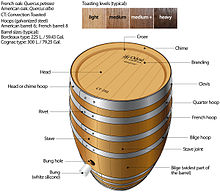 |
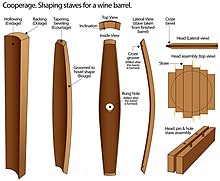 |
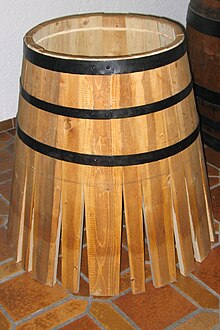
Barrels have a convex shape and bulge at their center, called bilge. This facilitatesrollinga well-built wooden barrel on its side and allows the roller to change directions with little friction, compared to acylinder.It also helps to distributestressevenly in the material by making the container more curved[citation needed].Barrels have reinforced edges to enable safe displacement by rolling them at an angle (in addition to rolling on their sides as described).[citation needed]
Casks used foraleorbeerhaveshivesandkeystonesin their openings. Before serving the beer, aspileis hammered into the shive and atapinto the keystone.[citation needed]
The wooden parts that make up a barrel are calledstaves,the top and bottom are both calledheadsorheaders,and the rings that hold the staves together are calledhoops.These are usually made of galvanized iron, though historically they were made of flexible bits of wood calledwithies.While wooden hoops could require barrels to be "fully hooped", with hoops stacked tightly together along the entire top and bottom third of a barrel, iron-hooped barrels only require a few hoops on each end.[32][page needed]
Wine barrels typically come in two hoop configurations. An American barrel features six hoops, from top to center:head- or chime hoop,quarter hoopandbilge hoop(times two), while a French barrel features eight, including a so-calledFrench hoop,located between the quarter- and bilge hoops (see "wine barrel parts" illustration).[citation needed]
The opening at the center of a barrel is called abung holeand the stopper used to seal it is abung.The latter is generally made of whitesilicone.[citation needed]
Sizes[edit]
A barrel is one of severalunitsofvolume,with dry barrels, fluid barrels (UK beer barrel, US beer barrel), oil barrel, etc. The volume of some barrel units is double others, with various volumes in the range of about 100–200 litres (22–44 imp gal; 26–53 US gal).
English wine casks[edit]
| gallon | rundlet | barrel | tierce | hogshead | puncheon, tertian | pipe, butt | tun | |
|---|---|---|---|---|---|---|---|---|
| 1 | tun | |||||||
| 1 | 2 | pipes, butts | ||||||
| 1 | 1+1⁄2 | 3 | puncheons, tertians | |||||
| 1 | 1+1⁄3 | 2 | 4 | hogsheads | ||||
| 1 | 1+1⁄2 | 2 | 3 | 6 | tierces | |||
| 1 | 1+1⁄3 | 2 | 2+2⁄3 | 4 | 8 | barrels | ||
| 1 | 1+3⁄4 | 2+1⁄3 | 3+1⁄2 | 4+2⁄3 | 7 | 14 | rundlets | |
| 1 | 18 | 31+1⁄2 | 42 | 63 | 84 | 126 | 252 | gallons (wine) |
| 3.785 | 68.14 | 119.24 | 158.99 | 238.48 | 317.97 | 476.96 | 953.92 | litres |
| 1 | 15 | 26+1⁄4 | 35 | 52+1⁄2 | 70 | 105 | 210 | gallons (imperial) |
| 4.546 | 68.19 | 119.3 | 159.1 | 238.7 | 318.2 | 477.3 | 954.7 | litres |
Pre-1824 definitions continued to be used in the US, thewine gallonof 231 cubic inches being the standardgallonfor liquids (the corn gallon of 268.8 cubic inches for solids). In Britain, the wine gallon was replaced by theimperial gallon. Thetiercelater became the petrol barrel. Thetunwas originally 256gallons,which explains from where the quarter, 8bushelsor 64 (wine) gallons, comes.
Brewery casks[edit]
| gallon | firkin | kilderkin | barrel | hogshead | Year designated | |
|---|---|---|---|---|---|---|
| 1 | hogsheads | |||||
| 1 | 1+1⁄2 | barrels | ||||
| 1 | 2 | 3 | kilderkins | |||
| 1 | 2 | 4 | 6 | firkins | ||
| 1 | 8 | 16 | 32 | 48 | ale gallons | (1454) |
| = 4.621 L | = 36.97 L | = 73.94 L | = 147.9 L | = 221.8 L | ||
| 1 | 9 | 18 | 36 | 54 | beer gallons | |
| = 4.621 L | = 41.59 L | = 83.18 L | = 166.4 L | = 249.5 L | ||
| 1 | 8+1⁄2 | 17 | 34 | 51 | ale gallons | 1688 |
| = 4.621 L | = 39.28 L | = 78.56 L | = 157.1 L | = 235.7 L | ||
| 1 | 9 | 18 | 36 | 54 | ale gallons | 1803 |
| = 4.621 L | = 41.59 L | = 83.18 L | = 166.4 L | = 249.5 L | ||
| 1 | 9 | 18 | 36 | 54 | imperialgallons | 1824 |
| = 4.546 L | = 40.91 L | = 81.83 L | = 163.7 L | = 245.5 L |
Although it is common to refer todraught beercontainers of any size as barrels, in the UK this is strictly correct only if the container holds 36 imperial gallons. The terms "keg"and" cask "refer to containers of any size, the distinction being that kegs are used forbeersintended to be served using external gas cylinders.Cask alesundergo part of their fermentation process in their containers, called casks.
Casks are available in several sizes, and it is common to refer to "afirkin"or" a kil "(kilderkin) instead of a cask.
The modern US beer barrel is 31 US gallons (117.34777 L), half a gallon less than the traditional wine barrel. (26 U.S.C. §5051[35])
Dry goods[edit]
Barrels are also used as a unit of measurement fordry goods(dry groceries), such as flour or produce. Traditionally, a barrel is 196 pounds (89 kg) of flour (wheat or rye), with other substances such as pork subject to more local variation. In modern times, produce barrels for all dry goods, excepting cranberries, contain 7,056 cubic inches, about 115.627 L.[36]
In the northeastern United States, nails, bolts, and plumbing fittings were commonly shipped in small rough barrels. These were small, 18 inches high by about 10–12 inches in diameter. The wood was the quality of pallet lumber. The binding was sometimes by wire or metal hoops or both. This practice seems to have been prevalent up till the 1980s. Older hardware stores probably still have some of these barrels.[citation needed]
See also[edit]
References[edit]
- ^"barrel".Oxford English Dictionary(Online ed.).Oxford University Press.(Subscription orparticipating institution membershiprequired.)
- ^"cask".Oxford English Dictionary(Online ed.).Oxford University Press.(Subscription orparticipating institution membershiprequired.)
- ^"vat".Oxford English Dictionary(Online ed.).Oxford University Press.(Subscription orparticipating institution membershiprequired.)
- ^"keg".Oxford English Dictionary(Online ed.).Oxford University Press.(Subscription orparticipating institution membershiprequired.)
- ^Terebelo, Binyomin (2022-01-01)."Oak Used To Create Casks For Aging Spirits Such As Made At Terebelo Distillery".Terebelo.
- ^Vierra, George."Barrel Flavors from Oak".
- ^"Guinness Collectors Club".The Guinness Coopers.Retrieved13 January2024.
- ^Kilby, K. (1989).The Cooper and His Trade.Linden Publishing Company. p. 91.ISBN978-0-941936-16-3.
- ^Twede, Diana (2005)."The cask age: The technology and history of wooden barrels".Packaging Technology and Science.18(5): 253–264.doi:10.1002/pts.696.S2CID110088268.
- ^
Rogers, Adam (2014). "Aging".Proof: The Science of Booze.Mariner books. Boston: Houghton Mifflin Harcourt. p. 109.ISBN9780547897967.Retrieved30 June2024.
In book I ofHistory,Herodotus says that Armenian wine merchants in the fifth century BC [...] could carry nearly 25 tons of wine along the Tigris and Euphrates Rivers to Babylon. Most wine histories say that Herodotus wrote that wine was transported in 'barrels made of palm tree wood' [...]. [...] But [...] The Armenians didn't have the wood to make the barrels. Herodotus uses the termbikos phoinikeiouto refer to the vessel holding the wine, andMcGovernsaysphoinikeiouprobably means 'Phoenician,' referring to a Phoenician-typeamphora.
- ^Kilby, p. 93.
- ^Pliny the Elder,The Natural History,Book XIV, Chap. 27,translated by John Bostock, H.T. Riley, Ed.
- ^Kilby, p. 96.
- ^Kilby, p. 98.
- ^abKilby, p. 99.
- ^Kilby, p. 102.
- ^Oak Barrels: French vs. AmericanArchived2007-06-02 at theWayback Machine.
- ^ab"27 C.F.R. sec 5.22(b)(1)(i)".Ecfr.GPOAccess.gov.Archived fromthe originalon 2012-08-17.Retrieved2010-08-05.
- ^"ASIL Insight: WTO Protections for Food Geographic Indications".Archivedfrom the original on 14 August 2007.Retrieved2007-08-25.
- ^"Canadian Food and Drug Regulations (C.R.C., c. 870) – Canadian Whisky, Canadian Rye Whisky or Rye Whisky (B.02.020)".Accessed on December 15, 2010.
- ^Lew Bryson (22 December 2008)."Seen Through a Glass".lewbryson.blogspot.Archivedfrom the original on 2015-01-03.
- ^"Barrels".iscbarrels.Archivedfrom the original on 2015-01-03.
- ^"Casks (barrels, butts, punchons, pipes, barriques, and hogsheads)",Difford's GuideArchived2015-12-22 at theWayback Machine.Accessed on December 17, 2015.
- ^"Tabasco Sauce History and Lore".The Spruce Eats.Retrieved2023-06-14.
- ^"thùng gỗ sồi".Retrieved14 June2023.
- ^abLópez-Alt, J. Kenji."Soda: The Dubious History (and Great Flavor) of Vernors Ginger Ale".Serious Eats.Archivedfrom the original on 5 January 2017.Retrieved3 April2017.
- ^Dixon, B. (March 2009)."The mystery of the warehouse stains (Animacules)"(PDF).Microbe.4(3): 104–105.Archived(PDF)from the original on 2016-03-03.
- ^Byland, Hannah (September 4, 2012)."Whiskey Aging Warehouses and the Effects to Surrounding Residential Neighborhoods in Louisville, Ky"(PDF).Louisville, Kentucky: Louisville, Kentucky government. Archived fromthe original(PDF)on May 10, 2013.RetrievedJuly 30,2014.
- ^"Does oil come in barrels?".Slate.24 March 2005.Archivedfrom the original on 2005-09-05.
- ^"Frequently Asked Questions".doe.gov.Archived fromthe originalon 2008-11-04.Retrieved2008-11-05.
- ^"What's In A Barrel of Oil?".ca.gov.19 July 2005. Archived fromthe originalon 30 April 2009.
- ^Keenan, D. (2013).Ireland 1603-1702, Society and History.Xlibris.ISBN978-1-4797-7919-2.
- ^"wine barrel".Sizes.2009-02-02.Retrieved2018-03-27.
- ^"English Beer and Ale Barrel".Sizes.2002-01-23.Retrieved2018-03-27.
- ^"27 CFR 25.11 - Meaning of terms".cornell.edu.Archivedfrom the original on 2017-07-09.
- ^"How big is the U.S. dry goods barrel?".sizes.Archivedfrom the original on 2012-09-26.
External links[edit]
- Chisholm, Hugh,ed. (1911)..Encyclopædia Britannica(11th ed.). Cambridge University Press.
